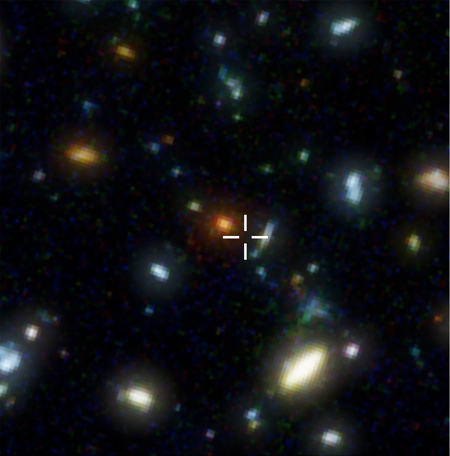News
Mystery of galaxy HDF850.1 finally resolved
An international team of astronomers has managed for the first time to determine the distance of the galaxy HDF850.1, well-known among astronomers as being one of the most productive star-forming galaxies in the observable universe. The galaxy is at a distance of 12.5 billion light years. Hence, we see it as it was 12.5 billion years ago, when the universe was less than 10% of its current age. Even more of a surprise, HDF850.1 turns out to be part of a group of around a dozen protogalaxies that formed within the first billion years of cosmic history – only one of two such primordial clusters known to date.
The galaxy HDF850.1 was discovered in 1998. It is famous for producing new stars at an incredible rate: the equivalent of a thousand new Suns per year. For comparison: an ordinary galaxy like our own forms only a few solar masses per year. Yet for the past fourteen years, the redshift of HDF850.1, which tells us its cosmological distance, remained unknown. How was that possible?
 |
| The region of the Hubble Deep Field where HDF850.1 is located. The cross indicates the submillimeter galaxy's position. For observations with ordinary, visible light telescopes such as the Hubble Space Telescope, the galaxy is completely invisible. Image credit: STScI / NASA, F. Walter (MPIA) |
The region in the sky where HDF850.1 is located affords an almost unparalleled view into the deepest reaches of space. Known as the ‘Hubble Deep Field’, it was first studied extensively in visible light with the Hubble Space Telescope. Yet these observations only reveal part of the cosmic picture, and astronomers were quick to follow-up the Hubble observations with other telescopes operating at longer wavelengths. In the late 1990s, astronomers using the James Clerk Maxwell Telescope on Hawaii surveyed the region in submillimeter radiation. This type of radiation, with wavelengths between a few tenths of a millimeter and a millimeter, is particularly suitable for detecting cool clouds of gas and dust.
The researchers were taken by surprise when they realized that HDF850.1 was the brightest source of submillimeter emission in the field by far, a galaxy that was evidently forming as many stars as all the other galaxies in the Hubble Deep Field combined – and which was completely invisible in the observations of the Hubble Space Telescope!
The galaxy’s invisibility is no great mystery. “Stars form in dense clouds of gas and dust. These dense clouds are opaque to visible light, hiding the galaxy from sight. Submillimeter radiation passes through the dense dust clouds unhindered, showing what is inside. But the lack of data from all but a very narrow range of the spectrum made it very difficult to determine the galaxy's redshift, and thus its place in cosmic history,” explains Fabian Walter of the Max Planck Institute for Astronomy in Heidelberg.
Now, an international group of astronomers led by Fabian Walter has finally solved the mystery. Taking advantage of recent upgrades to the IRAM interferometer located on the Plateau de Bure (Hautes-Alpes, France), which combines six radio antennas into a gigantic millimeter telescope, they have identified the characteristic features (“spectral lines” of carbon monoxide and ionized carbon) necessary for an accurate redshift measurement. “It is the availability of more powerful and sensitive instruments recently installed on the IRAM interferometer that allowed us to detect these weak lines in HDF850.1, and finally find what we had been unsuccessfully looking for, during the past 14 years,” explains Pierre Cox, Director of IRAM.
The result is a big surprise: The galaxy’s spectral lines have a redshift of 5.2, which means it is currently at a distance of 26 billion light-years from Earth. “We see HDF850.1 at a time when the universe itself was only 1.1 billion years old, and the intense star-forming activity taking place in this galaxy thus belongs to a very early period of cosmic history, when the universe was only 8% of its current age’ says Fabian Walter.
Once the redshift was known, the astronomers were able to put the galaxy into context. Using additional data from published and unpublished surveys, they were able to show that the galaxy is part of a group of a dozen other galaxies, spread over six million light-years, all at the same redshift. At this redshift, only one other galaxy group like this is known so far.
The new work highlights the importance of a powerful interferometer operating at millimeter and submillimeter wavelengths. “Both NOEMA, the future extension of the Plateau de Bure interferometer, and ALMA, a new interferometer array now being built by an international consortium in the Atacama desert in Chile, will cover submillimeter- and millimeter wavelengths in unprecedented detail, and should allow us to study many more galaxies, invisible at optical wavelengths, that were actively forming stars in the early universe”, says Chris Carilli from NRAO and Cambridge University.
Background information
The work described here has been published as F. Walter et al., "The Intense Starburst HDF850.1 in a Galaxy Overdensity at z = 5.2 in the Hubble Deep Field" on June 14th, 2012, issue of the journal Nature.
The authors are Fabian Walter (Max Planck Institute for Astronomy [MPIA] and National Radio Astronomy Observatory [NRAO], Socorro), Roberto Decarli (MPIA), Chris Carilli (NRAO and Cambridge University), Frank Bertoldi (University of Bonn), Pierre Cox (IRAM), Elisabete Da Cunha (MPIA), Emanuele Daddi (CEA Saclay), Mark Dickinson (NOAO, Tucson), Dennis Downes (IRAM), David Elbaz (CEA Saclay), Richard Ellis (Caltech), Jacqueline Hodge (MPIA), Roberto Neri (IRAM), Dominik Riechers (Caltech), Axel Weiss (Max Planck Institute for Radio Astronomy [MPIfR]), Eric Bell (University of Michigan, Ann Arbor), Helmut Dannerbauer (University od Vienna), Melanie Krips (IRAM), Mark Krumholz (UCSC), Lindley Lentati (Cambridge University), Roberto Maiolino (INAF-Osservatorio Astronomico di Roma and Cambridge University), Karl Menten (MPIfR), Hans-Walter Rix (MPIA), Brant Robertson (University of Arizona), Hyron Spinrad (UC Berkeley), Dan Stark (University of Arizona), and Daniel Stern (Jet Propulsion Laboratory).
Contact information
Pierre Cox, IRAM Director
Karin Zacher, Public Outreach Officer



